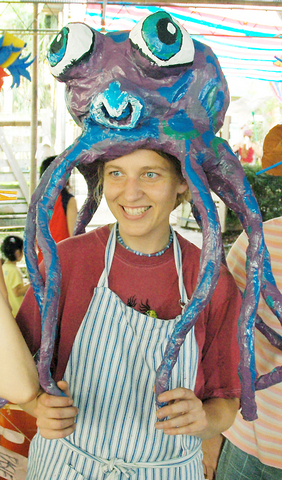The Dream Community Culture and Education Development Foundation's annual carnival (
Organized by the community arts organization, partly funded by the Taipei city and county governments, and local businesses, this year's parade takes as its theme the cycle of life. There are five parts, with sections on birth and creation, the connection between the individual, society and the natural world, the dislocation of the individual from the external world, metamorphosis and finally rebirth.
Thirty-four international artists from 12 countries, almost double last year's number, were invited to hold a series of community-based workshops held throughout September and early this month to prepare for the carnival.

PHOTOS COURTESY OF DREAM COMMUNITY
The parade, first held in 2002, adheres to an ethos that rejects commercialization. At the event, company signs or logos are forbidden and words are only allowed to appear on costumes if they are used poetically.
"It will be different from other parades in the sense that everything is very handmade. Really it's a celebration about members of the community finding the artist within themselves," said the artistic director for this year's festival, Andrew Kim.
The parade and pageant is the culmination of five weeks of work for the artists who organized activities with 11 local schools and workshops for local communities in the Shijr area.

The organizers are optimistic that tomorrow's festivities will attract as many as 3,000 to 4,000 participants. The route has been shortened and altered so the terrain is less difficult than last year's event and the road will be closed to traffic.
"On the one hand the response has been fabulous. But it took a little bit of getting used to, as the reaction in Taiwan is different than in the communities I work with in the States. It took a while for members of the community to feel comfortable making art with us. Sometimes they felt a little intimidated," Kim said.
For more information call, (02) 2695 6969, or visit www.dreamcommunity.org.tw


April 14 to April 20 In March 1947, Sising Katadrepan urged the government to drop the “high mountain people” (高山族) designation for Indigenous Taiwanese and refer to them as “Taiwan people” (台灣族). He considered the term derogatory, arguing that it made them sound like animals. The Taiwan Provincial Government agreed to stop using the term, stating that Indigenous Taiwanese suffered all sorts of discrimination and oppression under the Japanese and were forced to live in the mountains as outsiders to society. Now, under the new regime, they would be seen as equals, thus they should be henceforth

Last week, the the National Immigration Agency (NIA) told the legislature that more than 10,000 naturalized Taiwanese citizens from the People’s Republic of China (PRC) risked having their citizenship revoked if they failed to provide proof that they had renounced their Chinese household registration within the next three months. Renunciation is required under the Act Governing Relations Between the People of the Taiwan Area and the Mainland Area (臺灣地區與大陸地區人民關係條例), as amended in 2004, though it was only a legal requirement after 2000. Prior to that, it had been only an administrative requirement since the Nationality Act (國籍法) was established in

Three big changes have transformed the landscape of Taiwan’s local patronage factions: Increasing Democratic Progressive Party (DPP) involvement, rising new factions and the Chinese Nationalist Party’s (KMT) significantly weakened control. GREEN FACTIONS It is said that “south of the Zhuoshui River (濁水溪), there is no blue-green divide,” meaning that from Yunlin County south there is no difference between KMT and DPP politicians. This is not always true, but there is more than a grain of truth to it. Traditionally, DPP factions are viewed as national entities, with their primary function to secure plum positions in the party and government. This is not unusual

US President Donald Trump’s bid to take back control of the Panama Canal has put his counterpart Jose Raul Mulino in a difficult position and revived fears in the Central American country that US military bases will return. After Trump vowed to reclaim the interoceanic waterway from Chinese influence, US Defense Secretary Pete Hegseth signed an agreement with the Mulino administration last week for the US to deploy troops in areas adjacent to the canal. For more than two decades, after handing over control of the strategically vital waterway to Panama in 1999 and dismantling the bases that protected it, Washington has